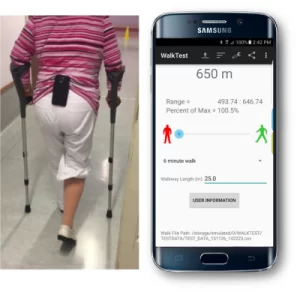 According to recent analyses, lower limb amputees have an even higher risk of falling than the healthy geriatric population—with a reported incidence of up to 80% in some cases—but have long been left out of research on fall risk and potential solutions. (iStock/Getty Images Plus/metamorworks)
According to recent analyses, lower limb amputees have an even higher risk of falling than the healthy geriatric population—with a reported incidence of up to 80% in some cases—but have long been left out of research on fall risk and potential solutions. (iStock/Getty Images Plus/metamorworks)
Accidental falls are the second leading cause of injury-related death in the entire global population, ranking first among people aged 65 years and older. Data from the Center for Disease Control and Prevention show that fall mortality in this age group increased by about 30% between 2009 and 2018.
To combat this growing danger, tech developers have begun rolling out products designed to either detect falls and automatically call for help, or predict the likelihood of them happening before they happen. A new AI algorithm on the block aims to achieve the second goal, but for a very specific group of patients: lower limb amputees.
According to recent analyses, this group has an even higher risk of falling than the healthy geriatric population—with a reported incidence of up to 80% in some cases—but has long been left out of research on fall risk and potential solutions.

A new AI-powered system developed by researchers from Canada and Slovenia attempts to fill this gap. Specifically, it accounted for the changes in gait that occur after lower limb amputations, resulting in an algorithm that can predict fall risk with similar accuracy to systems designed only with healthy older adults in mind.
As described in a study published this week in the journal PLOS Digital Health, a machine learning algorithm is built into a smartphone app. The smartphone is worn by the patient on the lower back during a standard six-minute walking test, known as the 6MWT.
After completing the walking part, the AI will go to work. It was trained to automatically mark each foot strike. This usually has to be done through a time-consuming manual process because most other fall risk algorithms have not been programmed to analyze “variability and instability” in amputees’ gait, according to the study authors.
Vayyar launches home-made radar sensor for remote fall detection
The study authors assigned the walking test to 80 participants, 27 of whom had experienced a fall within the previous six months and were therefore classified as having a higher risk of future falls. Each test was analyzed using manual labeling of foot strikes and automatic labeling of the new AI.
Although manual labeling was slightly more accurate in classifying fall risk in all patients, automated AI was shown to be equally capable of identifying patients at higher risk of falling, with both methods achieving a sensitivity of about 56%. Overall, the manual labeling approach achieved 80% accuracy compared to just over 72% for the AI, which was slowed by the six additional false positives it produced.
Overall, the researchers concluded that these results suggest that the algorithm is a viable option to help calculate fall risk in lower limb amputees and could therefore be “integrated into a smartphone application to provide clinical assessment immediately after the 6MWT.” .